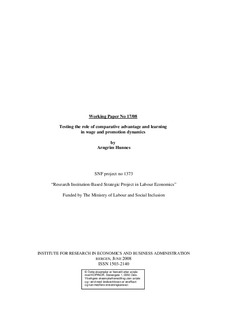| dc.contributor.author | Hunnes, Arngrim | |
| dc.date.accessioned | 2008-12-18T11:23:24Z | |
| dc.date.available | 2008-12-18T11:23:24Z | |
| dc.date.issued | 2008-06 | |
| dc.identifier.issn | 1503-2140 | |
| dc.identifier.uri | http://hdl.handle.net/11250/166192 | |
| dc.description.abstract | Can job assignment based on comparative advantage and learning about workers’ ability explain wage and promotion dynamics within firms? In order to answer this question the Gibbons and Waldman (1999b) model is estimated in a Generalized Method of Moments (GMM) framework using a unique data set on white-collar workers in Norway for the years 1987-1997. The estimation is carried out on two different occupational groups: technical and administrative white-collar workers. The selection of workers into a given position within a firm hierarchy is based on comparative advantage. Both measurable and unmeasurable skills are important. This holds in both occupations studied. When it comes to firms’ learning about their workers, the results are not so clear. But overall, the results on learning seem to have stronger support than what previous studies have found. In general, there is more evidence for learning about administrative white-collar workers than about technical white-collar workers. | en |
| dc.language.iso | eng | en |
| dc.publisher | SNF | en |
| dc.relation.ispartofseries | Working paper | en |
| dc.relation.ispartofseries | 2008:17 | en |
| dc.subject | internal labor markets | en |
| dc.subject | promotion | en |
| dc.subject | wages | en |
| dc.subject | comparative advantage | en |
| dc.subject | learning | en |
| dc.subject | linked emplyer-employee data | en |
| dc.title | Testing the role of comparative advantage and learning in wage and promotion dynamics | en |
| dc.type | Working paper | en |
